The Influence of the Privatization Process on Accident Rates in the Forestry Sector in Poland
Abstract
1. Introduction
2. Materials and Methods
2.1. Data
- (1)
- Non-fatal accident rate—the number of accidents per 1000 employees;
- (2)
- Fatal accident rate—the number of fatalities per 1000 employees;
- (3)
- Non-fatal accident rate per production unit—the number of non-fatal accidents for each 1 million m3 of harvested timber;
- (4)
- Fatal accident rate per production unit—the number of fatalities for each 1 million m3 of harvested timber;
- (5)
- Number of lost working days—the total number of days of absence from work (excluding fatal accidents);
- (6)
- Accident severity rate—the average number of days of incapacity for work confirmed by medical certificate.
2.2. Procedure
2.3. Statistical Analysis
3. Results
3.1. Number of Accidents
3.2. Accident Incidence Rates
3.3. Accident Severity Rates
3.4. Accident Causes
4. Discussion
5. Conclusions
Author Contributions
Funding
Acknowledgments
Conflicts of Interest
References
- International Labour Organisation (ILO). Occupational Injuries. Available online: https://www.ilo.org/ilostat-files/Documents/description_INJ_EN.pdf (accessed on 20 April 2020).
- Hämäläinen, P. The effect of globalization on occupational accidents. Saf. Sci. 2009, 47, 733–742. [Google Scholar] [CrossRef]
- Eurostat. Accidents at Work—Statistics by Economic Activity. Available online: https://ec.europa.eu/eurostat/statistics-explained/index.php/Accidents_at_work_-_statistics_by_economic_activity (accessed on 3 March 2020).
- International Labour Organisation (ILO). Occupational Safety and Health in Forestry; Forestry and Wood Industries Committee; Second Session; Report III; ILO: Geneva, Switzerland, 1991; 73p. [Google Scholar]
- Lilley, R.; Feyer, A.-M.; Kirk, P.; Gander, P. A survey of forest workers in New Zealand. J. Saf. Res. 2002, 33, 53–71. [Google Scholar] [CrossRef]
- Thelin, A. Fatal accidents in Swedish farming and forestry, 1988–1997. Saf. Sci. 2002, 40, 501–517. [Google Scholar] [CrossRef]
- Klun, J.; Medved, M. Fatal accidents in forestry in some European countries. Croat. J. For. Eng. 2007, 28, 55–62. [Google Scholar]
- Rhee, K.Y.; Choe, S.W.; Kim, Y.S.; Koo, K.H. The trend of occupational injuries in Korea from 2001 to 2010. Saf. Health Work 2013, 4, 63–70. [Google Scholar] [CrossRef]
- Gandaseca, S.; Yoshimura, T. Occupational safety, health and living conditions of forestry workers in Indonesia. J. For. Res. 2001, 6, 281–285. [Google Scholar] [CrossRef]
- Wang, J.; Bell, J.L.; Grushecky, S.T. Logging injuries for a 10-year period in Jilin Province of the People’s Republic of China. J. Saf. Res. 2003, 34, 273–279. [Google Scholar] [CrossRef]
- Grzywiński, W.; Sawa, L.; Nowik, A.; Nowicki, G. Structure of work accidents in the Regional Directorate of the State Forest in Szczecinek in the years 1990−2009. Sylwan 2013, 157, 403–414, (In Polish with English Summary). [Google Scholar] [CrossRef]
- Enez, K.; Topbas, M.; Acar, H.H. An evaluation of the occupational accidents among logging workers within the boundaries of Trabzon Forestry Directorate, Turkey. Int. J. Ind. Ergon. 2014, 44, 621–628. [Google Scholar] [CrossRef]
- Rodriguez-Acosta, R.; Loomis, D.P. Fatal occupational injuries in the forestry and logging industry in North Carolina, 1977–1991. Int. J. Occup. Environ. Health 1997, 3, 259–265. [Google Scholar] [CrossRef]
- Mitchell, R.; Driscoll, T.; Healey, S.; Mandryk, J.; Hendrie, L.; Hull, B. Fatal injuries in forestry and logging work in Australia, 1989 to 1992. J. Occup. Health Saf. Aust. N.Z. 2001, 17, 567–577. [Google Scholar]
- Bentley, T.A.; Parker, R.J.; Ashby, L. Understanding felling safety in the New Zealand forest industry. Appl. Ergon. 2005, 36, 165–175. [Google Scholar] [CrossRef]
- Potočnik, I.; Pentek, T.; Poje, A. Severity analysis of accidents in forest operations. Croat. J. For. Eng. 2009, 30, 171–184. [Google Scholar]
- Tsioras, P.A.; Rottensteinner, C.; Stampfer, K. Analysis of accident during cable yarding operation in Austria 1998–2008. Croat. J. For. Eng. 2011, 32, 549–560. [Google Scholar]
- Tsioras, P.A.; Rottensteinner, C.; Stampfer, K. Wood harvesting accidents in the Austrian State Forest Enterprise 2000–2009. Saf. Sci. 2014, 62, 400–408. [Google Scholar] [CrossRef]
- Nowacka, W.Ł.; Moskalik, T. The negative effects of working in forestry with special focus on timber harvesting. For. Lett. 2013, 105, 85–93, (In Polish with English Summary). [Google Scholar]
- Melemez, K. Risk factor analysis of fatal forest harvesting accidents: A case study in Turkey. Saf. Sci. 2015, 79, 369–378. [Google Scholar] [CrossRef]
- Gifford, M. Safety and Health in the European Forestry Sector—The Impact of More Open Markets and of Increased Regulation; Working Paper 264; ILO: Geneva, Switzerland, 2009; pp. 1–29. Available online: https://www.ilo.org/wcmsp5/groups/public/---ed_dialogue/---sector/documents/publication/wcms_160880.pdf (accessed on 3 March 2020).
- Suchomel, J.; Belanová, K. Influence of selected meteorological phenomena on work injury frequency in timber harvesting process. Croat. J. For. Eng. 2009, 34, 311–320. [Google Scholar]
- Gejdoš, M.; Vičková, M.; Allmanová, Z.; Balážová, Ž. Trends in workplace injuries in Slovak forest enterprises. Int. J. Environ. Res. Public Health 2019, 16, 141. [Google Scholar] [CrossRef]
- Grzywiński, W.; Kapelan, A.; Wiekiera, J. Analysis of accident rate in the Regional Directorate of the State Forests in Poznań in the years 1995–2007. In Technology and Ergonomics in the Service of Modern Forestry; Sowa, J.M., Barszcz, A., Szewczyk, G., Eds.; Wyd. UR w Krakowie: Kraków, Poland, 2011; pp. 55–71. [Google Scholar]
- Statistical Yearbook of Forestry (SYF) from 1990 to 2018. Available online: https://stat.gov.pl/en/topics/agriculture-forestry/forestry (accessed on 3 March 2020).
- Statistics Poland (SP). Accidents at Work in 2017. Available online: https://stat.gov.pl/en/topics/labour-market/working-conditions-accidents-at-work/accidents-at-work-in-2017,3,11.html (accessed on 3 March 2020).
- Garland, J.J. Accident Reporting and Analysis in Forestry: Guidance on Increasing the Safety of Forest Work; Forestry Working Paper 2; FAO: Rome, Italy, 2018; pp. 1–77. Available online: http://www.fao.org/3/i9180en/I9180EN.pdf (accessed on 3 March 2020).
- Bureau of Labor Statistics (BLS). Census of Fatal Occupational Injuries 2017. Available online: https://www.bls.gov/iif/oshwc/cfoi/cfch0016.pdf (accessed on 3 March 2020).
- Gaskin, J.E.; Parker, J.R. Accidents in forestry and logging operations in New Zealand. Unasylva 1993, 44, 19–24. [Google Scholar]
- Smith, S.; de Hoop, C.; Marx, B.; Pine, J. Logging injuries in Louisiana: Nature, trends, and rehabilitation considerations. Work 1999, 12, 261–273. [Google Scholar] [PubMed]
- Scott, D.F. A study of logger fatalities from 1992–2000. Inj. Prev. 2004, 10, 239–243. [Google Scholar] [CrossRef] [PubMed]
- Brodie, L.R.; Ibrahim, J.E. Fatal injury in tree falling and related activities, Victoria, Australia 1992–2007. Inj. Prev. 2010, 16, 53–56. [Google Scholar] [CrossRef] [PubMed]
- Ghaffariyan, M.R. Analysis of forestry work accidents in five Australian forest companies for the period 2004 to 2014. J. For. Sci. 2016, 62, 545–552. [Google Scholar] [CrossRef]
- Laschi, A.; Marchi, E.; Foderi, C.; Neri, F. Identifying causes, dynamics and consequences of work accidents in forest operations in an alpine context. Saf. Sci. 2016, 89, 28–35. [Google Scholar] [CrossRef]
- Ackerknecht, C.G. Occupational accidents footprint: New concept linked to chain of custody in sustainable forest management. Cienc. Trab. 2014, 16, 131–136. [Google Scholar] [CrossRef]
- Christian, M.S.; Bradley, J.C.; Wallace, J.C.; Burke, M.J. Workplace safety: A meta-analysis of the roles of person and situation factors. J. Appl. Psychol. 2009, 94, 1103–1127. [Google Scholar] [CrossRef]
- Holcroft, C.A.; Punnett, L. Work environment risk factors for injuries in wood processing. J. Saf. Res. 2009, 40, 247–255. [Google Scholar] [CrossRef]
- Mederski, P.S.; Karaszewski, Z.; Rosińska, M.; Bembenek, M. Dynamics of harvester fleet change in Poland and factors determining machine occurrence. Sylwan 2016, 160, 795–804, (In Polish with English Summary). [Google Scholar] [CrossRef]
- Moskalik, T.; Borz, S.A.; Dvořák, J.; Ferencik, M.; Glushkov, S.; Muiste, P.; Lazdiņš, A.; Styranivsky, O. Timber harvesting methods in Eastern European countries: A review. Croat. J. For. Eng. 2017, 38, 231–241. [Google Scholar]
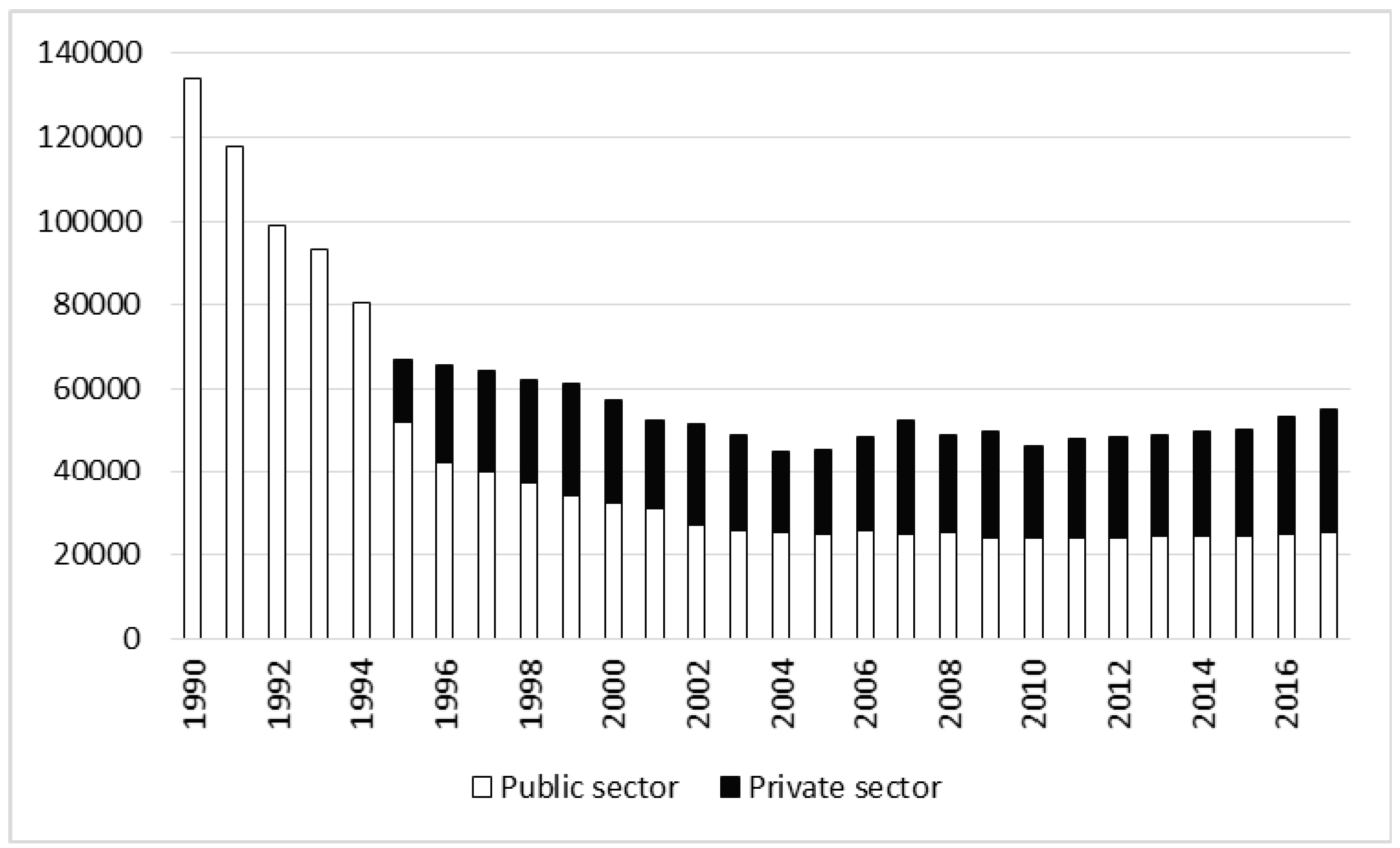
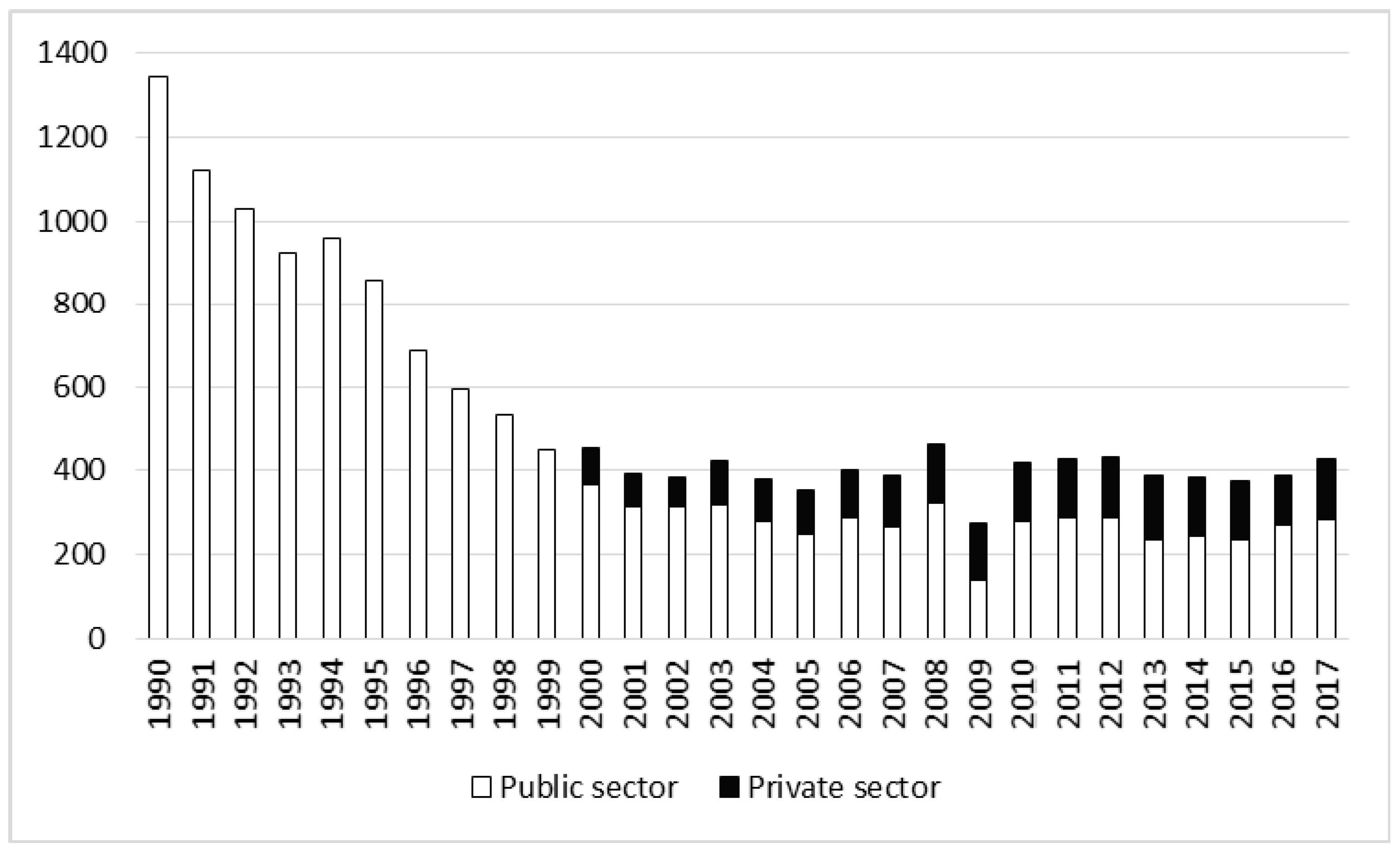
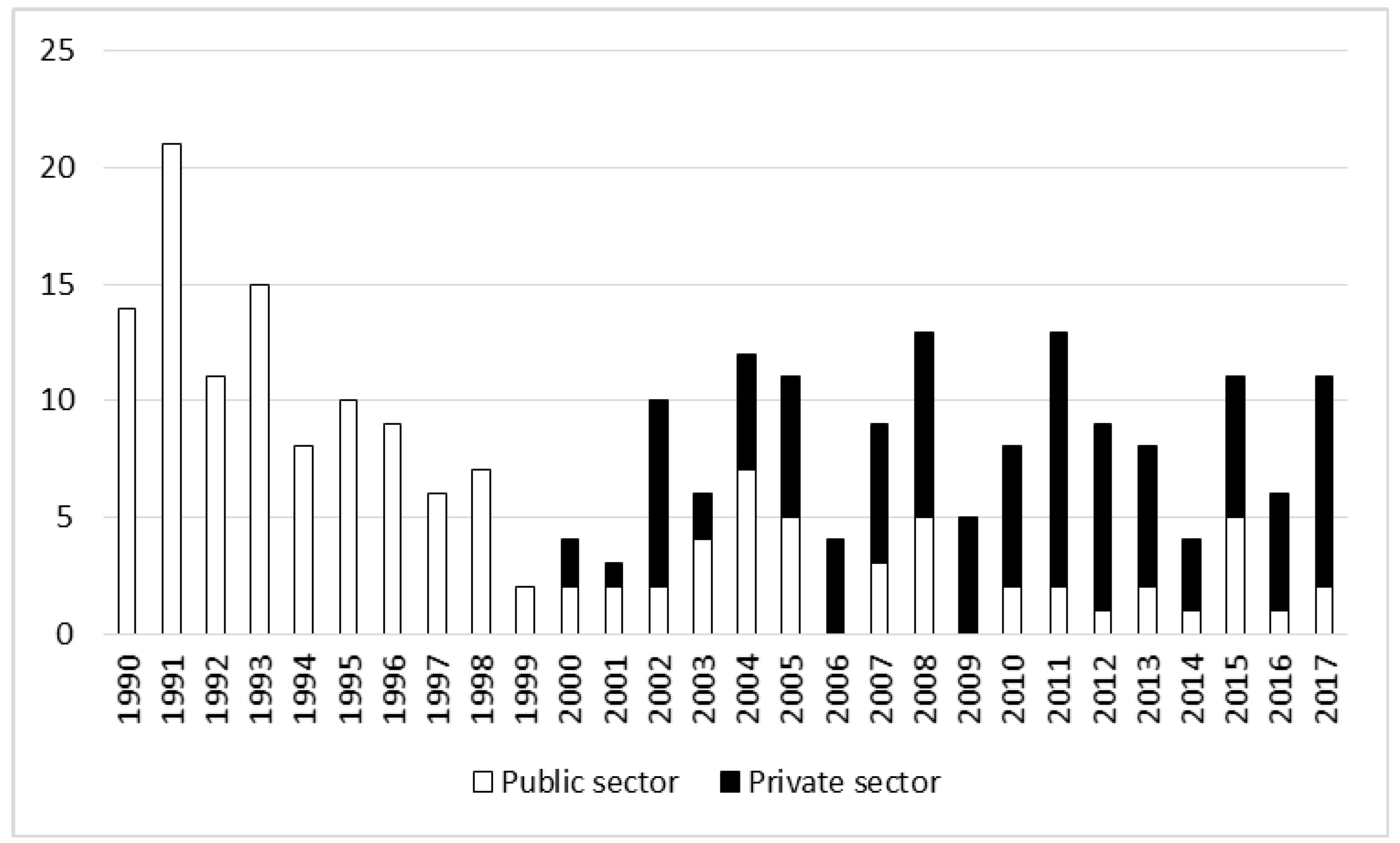

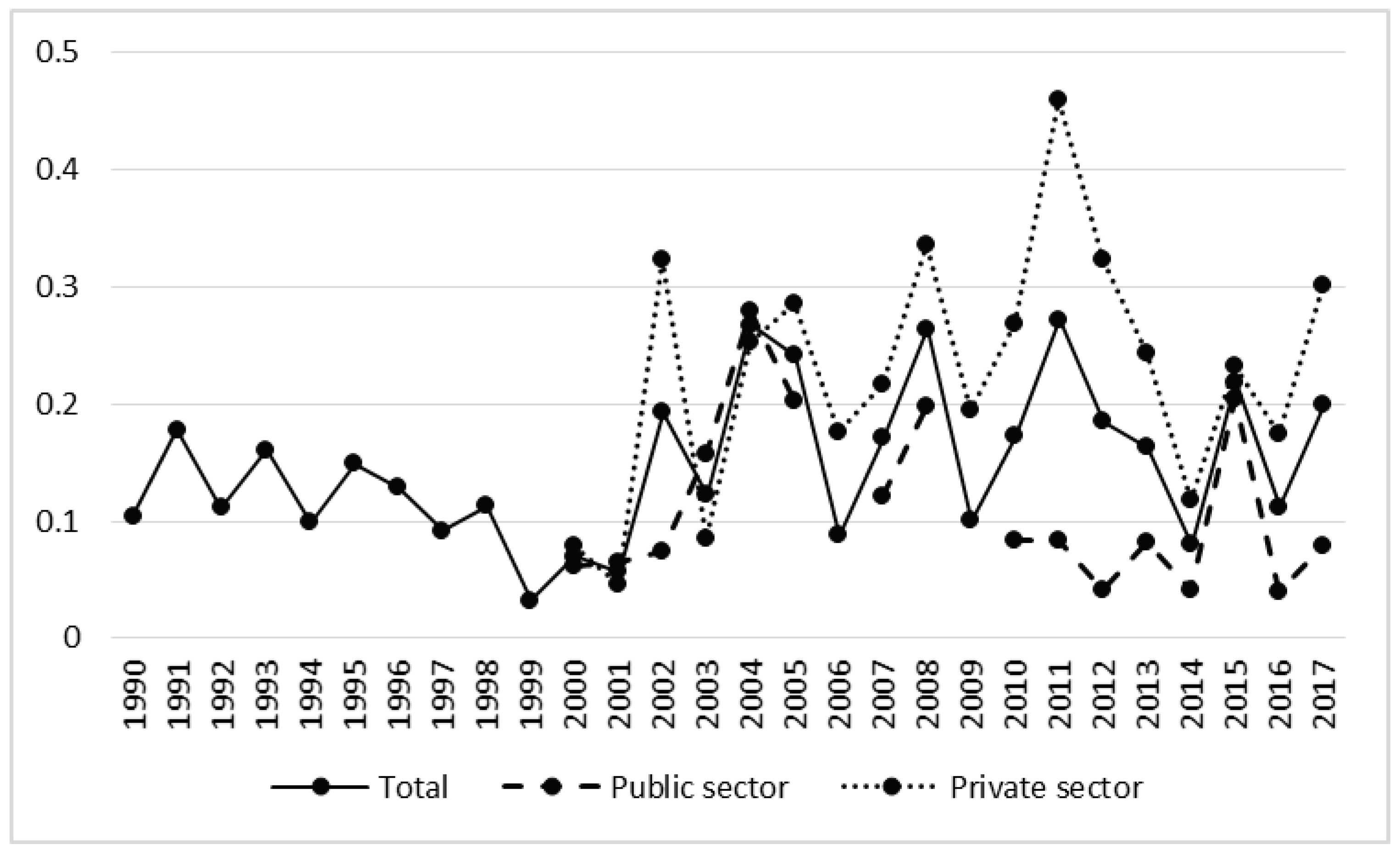
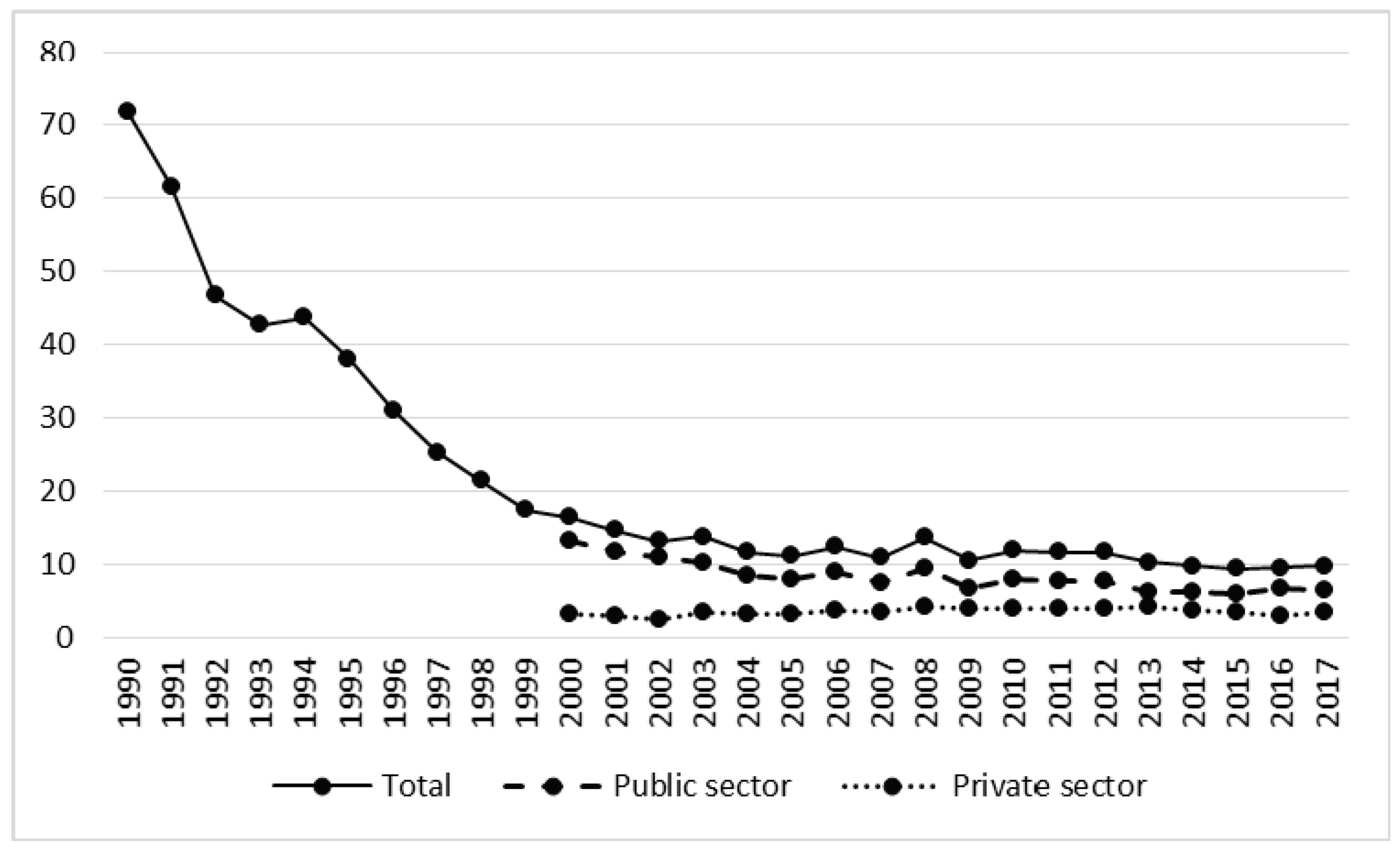

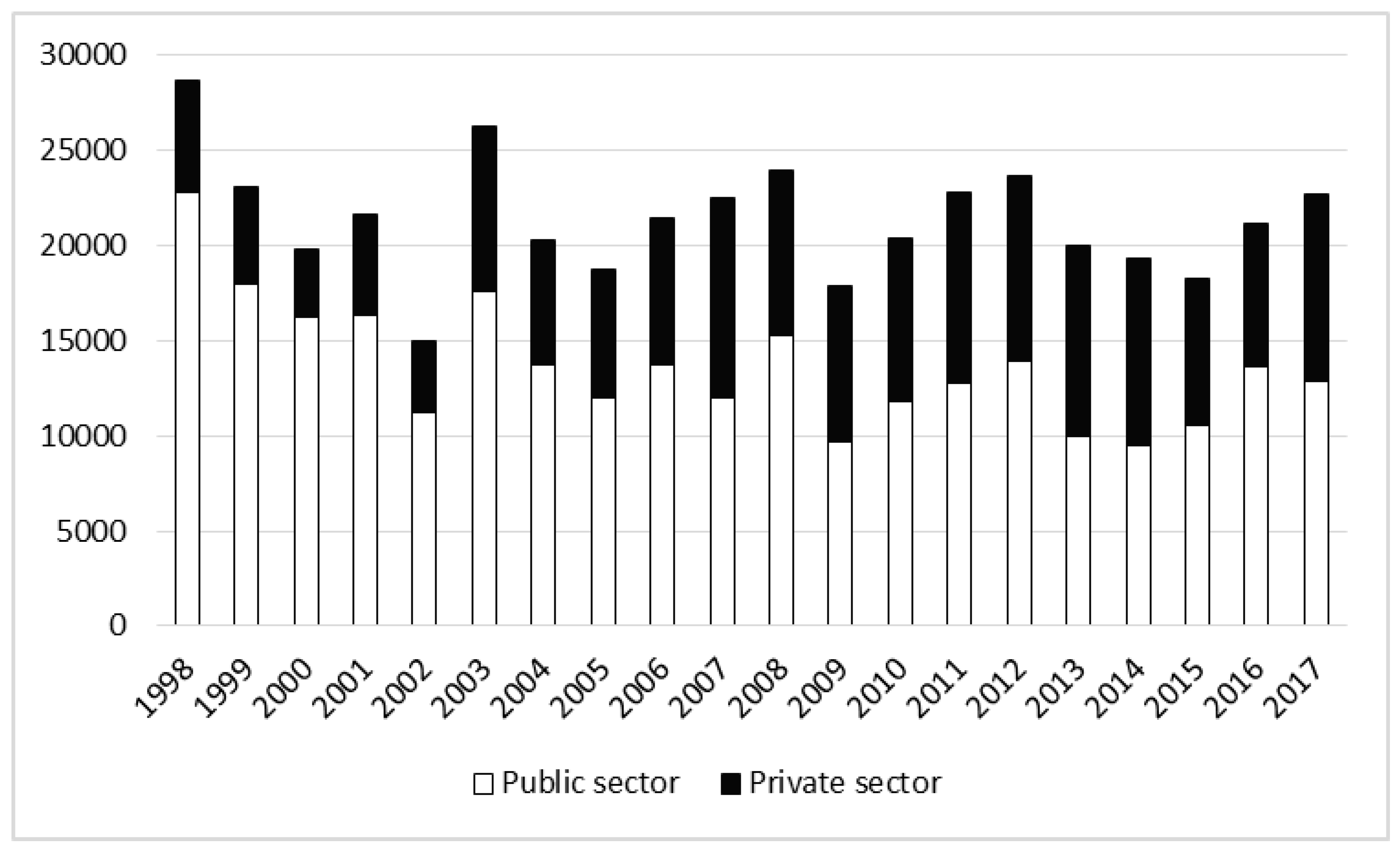
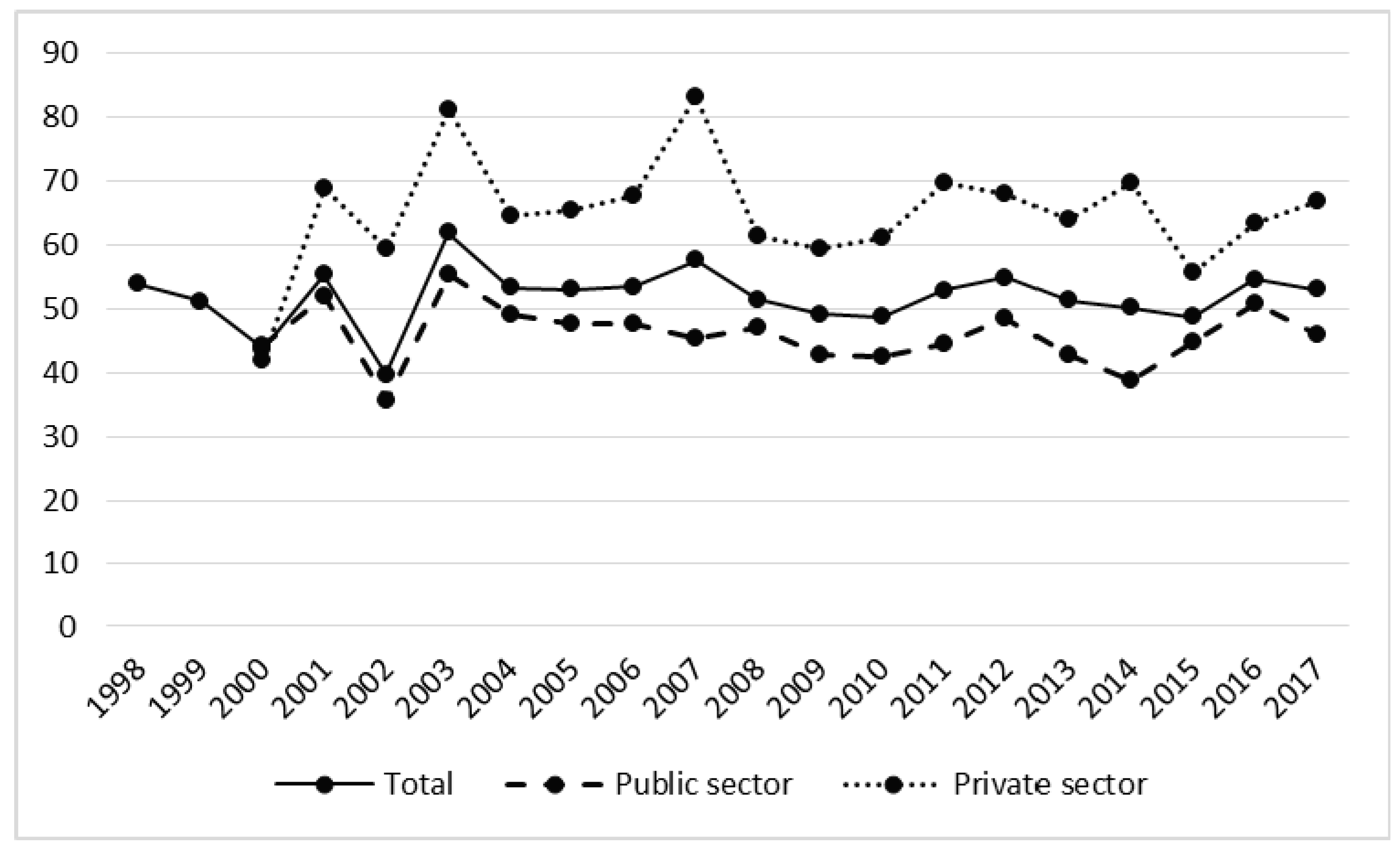
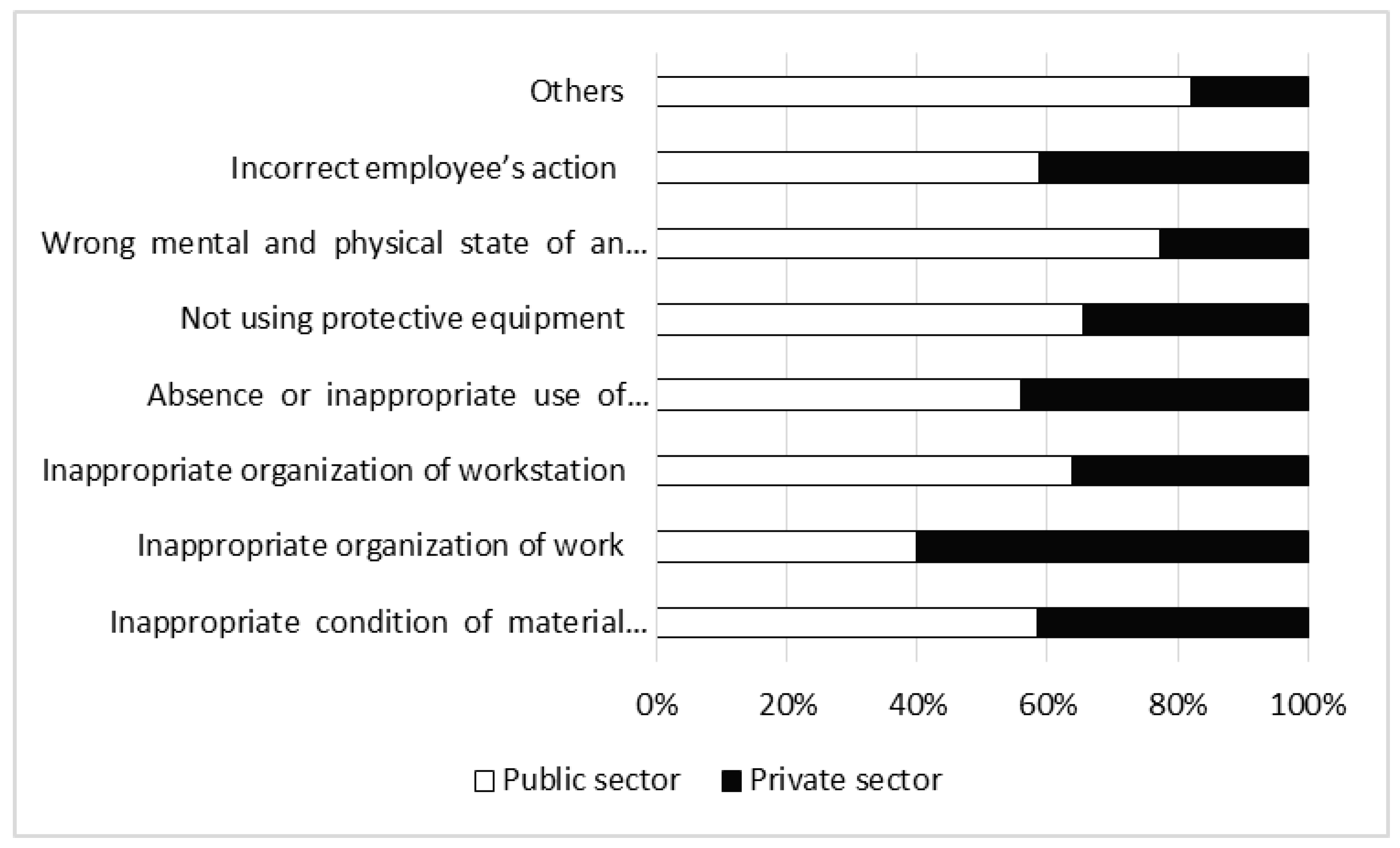
| Forestry Sector | Number of Employees | Number of Non-Fatal Accidents | Number of Fatal Accidents | Non-Fatal Accident Rate | Fatal Accident Rate | Non-Fatal Accident Rate per Production Unit | Fatal Accident Rate per Production Unit | Number of Lost Days | Severity Rate |
|---|---|---|---|---|---|---|---|---|---|
| 1990 | |||||||||
| Public | 134,000 | 1343 | 14 | 10.02 | 0.10 | 71.91 | 0.75 | No data | No data |
| 1991–2002 | |||||||||
| Public | 57,223 * | 331.3 2 | 2 2 | 11.06 | 0.07 | 11.95 2 | 0.07 2 | 20,583.3 3 | 43.96 3 |
| Private | 23,267 1 | 76.3 2 | 3.67 2 | 3.21 | 0.15 | 2.76 2 | 0.13 2 | 4300 3 | 56.69 3 |
| Total | 73,115 * | 697.4 * | 8.83 | 9.33 * | 0.12 * | 30.98 * | 0.40 | 24,883.3 3 | 48.75 3 |
| 2003–2017 | |||||||||
| Public | 24,645 * | 270.7 | 2.67 | 10.98 | 0.11 | 7.54 | 0.07 | 12,601 | 46.30 |
| Private | 24,652 | 130.7 | 6.00 | 5.32 | 0.24 | 3.60 | 0.16 | 8702 | 66.86 |
| Total | 49,135 * | 401.4 * | 8.67 | 8.19 * | 0.18 * | 11.14 * | 0.23 | 21,303 | 53.02 |
| Characteristics | Public Sector | Private Sector | Total |
|---|---|---|---|
| Number of employees | −0.89 * | 0.47 * | −0.68 * |
| Number of non-fatal accidents | −0.56 * | 0.81 * | −0.70 * |
| Number of fatal accidents | −0.26 | 0.44 | −0.10 |
| Non-fatal accident rate | −0.23 | 0.53 * | −0.57 * |
| Fatal accident rate | −0.17 | 0.26 | 0.32 |
| Non-fatal accident rate per production unit | −0.88 * | 0.21 | −0.95 * |
| Fatal accident rate per production unit | −0.60 * | 0.34 | −0.52 * |
| Number of lost days | −0.67 * | 0.71 * | −0.30 |
| Severity rate | −0.18 | 0.24 | 0.08 |
© 2020 by the authors. Licensee MDPI, Basel, Switzerland. This article is an open access article distributed under the terms and conditions of the Creative Commons Attribution (CC BY) license (http://creativecommons.org/licenses/by/4.0/).
Share and Cite
Grzywiński, W.; Skonieczna, J.; Jelonek, T.; Tomczak, A. The Influence of the Privatization Process on Accident Rates in the Forestry Sector in Poland. Int. J. Environ. Res. Public Health 2020, 17, 3055. https://doi.org/10.3390/ijerph17093055
Grzywiński W, Skonieczna J, Jelonek T, Tomczak A. The Influence of the Privatization Process on Accident Rates in the Forestry Sector in Poland. International Journal of Environmental Research and Public Health. 2020; 17(9):3055. https://doi.org/10.3390/ijerph17093055
Chicago/Turabian StyleGrzywiński, Witold, Joanna Skonieczna, Tomasz Jelonek, and Arkadiusz Tomczak. 2020. "The Influence of the Privatization Process on Accident Rates in the Forestry Sector in Poland" International Journal of Environmental Research and Public Health 17, no. 9: 3055. https://doi.org/10.3390/ijerph17093055
APA StyleGrzywiński, W., Skonieczna, J., Jelonek, T., & Tomczak, A. (2020). The Influence of the Privatization Process on Accident Rates in the Forestry Sector in Poland. International Journal of Environmental Research and Public Health, 17(9), 3055. https://doi.org/10.3390/ijerph17093055







